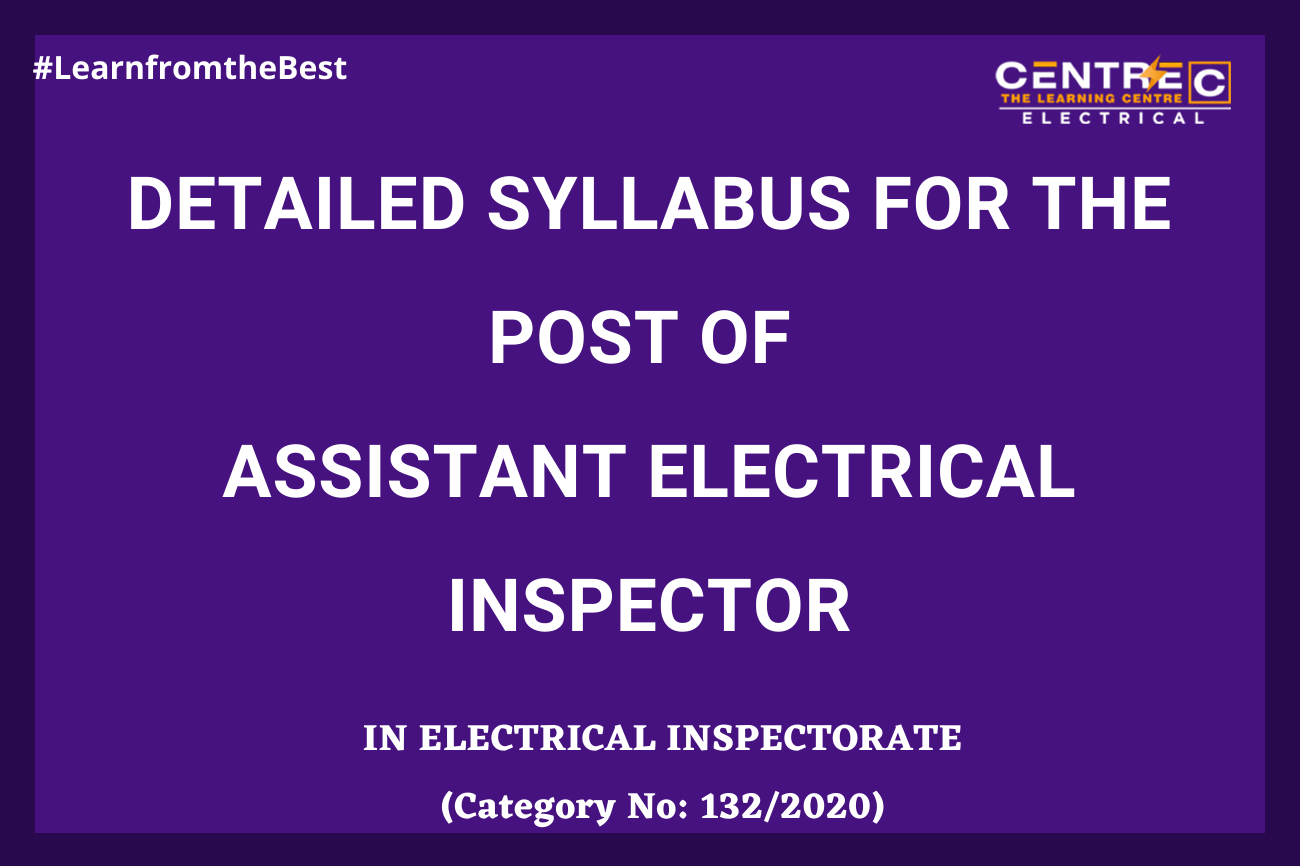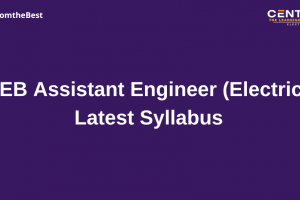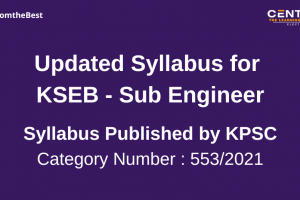
Assistant Electrical Inspector Syllabus
Detailed Syllabus for Assistant Electrical Inspector
(Category No. 132/2020)
Basic Electrical Engineering
- Concept of EMF and Potential difference – Drift velocity – Relation between current and drift velocity – Resistance – Resistivity or specific resistance – Conductance – Conductivity – Power rating of resistor – Carbon resistors and their colour code – Effect of temperature on resistance – Temperature coefficient of resistance OHM’S LAW – Ohmic and Non-ohmic conductors
- Work – Energy – Electric Power – Units of Power – Electrical Energy – Commercial unit of Electrical energy – Thermal energy – Efficiency Heating effect of Electric Current – Joules law – Applications – Fuses Electrical materials: Conductors, Insulators and Semiconductors
- INDUCTOR – Introduction – Current-Voltage relation of Inductor – Energy stored in an inductor – Combination of Inductors: Series and Parallel
- CAPACITANCE – Its importance – Current-Voltage relation for a Capacitor – Capacitance of Parallel Plate – Relative Permittivity or Dielectric Constant – Dielectric Strength – Energy Stored in a Charged Capacitor – Energy density – Combination of Capacitors: Series and Parallel Types of Capacitors
Electrostatic & Magnetism
- ELECTROSTATICS – Coulomb’s Law of Electrical Force – Absolute and Relative Permittivity – Gauss Theorem – Electric Field – Electric Field Intensity or Field Strength – Electric Field Intensity due to a point Charge & group of point charges – Electric Flux – Flux density – Electron volt
- ELECTROMAGNETIC INDUCTION – Flux Linkages – Faraday’s Law of EMI – Induced EMF – Direction of Induced EMF and Current ( Lenz’s Law, Fleming’s Right Hand Rule) – Statically Induced EMF(Self and Mutually Induced EMF) – Dynamically Induced EMF – Self Inductance – Mutual Inductance – Inductance of a Solenoid – Coefficient of Coupling – Magnetically Coupled Coils
- MAGNETISM & ELECTROMAGNETISM – Magnets – Permanent and Temporary magnets – Laws of Magnetic Force – Magnetic Field – Magnetic effect of Electric Current (Right Hand rule, Cross-dot notation) – Magnetic Flux – Manetic Flux density – Magnetic Circuit – Magnetomotiveforce – Magnetic Field Intensity – Absolute and Relative Permeability – Relation between B & H Classification of materials: Paramagnetic, Diamagnetic, Ferromagnetic materials
- Magnetic force on a Current carrying Conductor – Direction of Force (Right Hand Rule) – Biot-Savart’s Law – Ampere’s Circuital Law – Magnetic field due to Straight Current carrying Conductor – Right Hand Grip Rule
- MAGNETIC CIRCUIT – Definition – Analysis of Magnetic Circuit – mmf – Reluctance – Permeance – Air gaps in Magnetic Circuits – Calculation of Ampere-turns – Magnetic Leakage Flux – B-H Curve or Magnetisation Curve for Magnetic and Non-magnetic materials
- Hysterisis Loop (Residual Flux density , Retentivity, Coercive force) – Importance of Hysterisis Loop – Hysterisis Loss – Steinmetz Hysterisis Law – Eddy Current – Eddy Current Power Loss
Network Theory
- DIRECT CURRENT – Resistors in Series and Parallel – DC Series-Parallel circuit
- NETWORK THEOREMS – Active element – Passive element – Node – Junction – Branch – Loop – Mesh – KIRCHHOFF’s LAW – KCL – KVL – Sign Convention – Ideal and Practical Voltage Sources -Ideal and Practical Current Sources
- Source Conversion – Maxwell’s Mesh Current method – Nodal analysis – Superposition theorem
- Thevenin’s theorem – Norton’s theorem – Maximum Power Transfer theorem – Delta to Star Conversion – Star to Delta Conversion
- ALTERNATING CURRENT – Alternating Voltage and Current Technical Terms: Instantaneous Value – Cycle – Alternation – Time Period – Frequency – Amplitude – Angular Frequency and Frequency – Frequency and Speed -Average Value of AC – RMS or Effective value of AC – Form Factor – Peak Factor – Phase and Phase difference – Phasor Diagram of Sine wave – AC through Pure Resistor, Inductor, Capacitor – Inductive and Capacitive Reactance
- Transient response of DC & AC networks: Transient Voltage or Current – Charging of a Capacitor – Discharging of a Capacitor – Closing and Breaking of R-L Circuit – Rise and Decay of Current in R-L DC Circuit – Time Constant – Application to AC Circuits – RL, RC, RLC Series AC Circuit – Maximum Power Transfer for ac Circuits – Application to AC Circuits – RL, RC, RLC Series AC Circuit – Maximum Power Transfer for ac Circuits
- SERIES AC CIRCUIT – R-L Series AC Circuit – Impedance Triangle – Power factor – it’s Significance – True and Reactive Power – Power Triangle- R-C Series AC Circuit – R-L-C Series AC Circuit Resonance in AC Circuit – Series Resonance – Q factor – Band Width
- PARALLEL AC CIRCUIT – Importance – R-C Parallel Circuit – Solution of Parallel Circuits – Admittance Triangle – Resonance in Parallel AC Circuit – Q factor – Band Width – Comparison of Series and Parallel Resonant Circuits – Basic Filter Concepts
- Three Phase Circuit – Introduction – Interconnection (Star & Delta) : analysis – Power Measurement – Determination of Power factor using Wattmeter method – Power factor Improvement & Correction
- Two Port network – Interconnection of networks
Electrical Machines
- DC GENERATOR – Principle – Constructional features – Windings (Lap and Wave) – EMF equation – Armature Resistance – Types of generator (Separately & Self excited) – Applications – Losses -Power Stages – Condition for maximum Efficiency
- Armature Reaction – Effects – Commutation – Methods of improving Commutation – Generator characteristics for different types of Generators – Critical Field Resistance & Critical Speed
- DC MOTOR – Principle – Constructional features – Back emf – Voltage equation – Power equation – Torque equation(Armature, Shaft, Bhp) – Condition for maximum Mechanical Power – Types of motors, their Characteristics & Applications – Factors controlling Motor Speed – Speed Regulation
- Speed control methods of shunt, series and compound motors – Starting of DC motors – Starter Types and its necessity – Losses – Efficiency – Power stages
- TRANSFORMER – Principle – Working – EMF equation – Voltage Transformation Ratio – Ideal and Practical Transformer(No Load, On Load) – Equivalent Circuit – Voltage Regulation – Transformer Tests (OC, SC and Sumpner’s tests) – Losses – Efficiency – Maximum efficiency(Condition, Output KVA)
- Distribution transformer – All day efficiency – Cooling – Three phase transformer – connections – Parallel operation – Autotransformer – Principle- Saving of copper
- ALTERNATOR – Introduction – Construction (Salient pole & Non-salient pole) – Working – Winding factor(Distribution & Pitch factor) – Excitation methods – EMF equation – Frequency of Induced emf – Alternator on No Load and ON Load
- Armature reaction – Phasor diagram – Voltage Regulation – Output Power – Losses -Cooling systems – Parallel operation – Synchronising Power – Hunting
- SYNCHRONOUS MOTOR – Introduction – Construction – Principle – Methods of Starting – Pull out torque – Power Relation – Motor torque – Mechanical power – Characteristics – Power factor of Synchronous Motor – Synchronous Capacitor – Applications
- INDUCTION MOTOR – Introduction(Single and Three Phase IM) – Construction (Squirrel Cage & Slip Ring) – Operation – Synchronous Speed – Slip – Rotor Current, Frequency & Torque – Starting Torque – Torque-Slip Characteristics – IM Torque (Full Load, Starting, Maximum torque)
- Speed Regulation – Speed Control – Power Stages – Output Power – Methods of Starting -Applications – Ceiling fan – Comparison between Synchronous & Induction motors
- SINGLE PHASE MOTOR – Introduction – Single Phase IM (Self Starting) – Split Phase IM – Capacitor Start Motor – Capacitor Start Capacitor Run Motor – Shaded-Pole Motor – AC Series or Universal Motor – Repulsion Motor – Single Phase Synchronous Motor – Reluctance Motor – Hysterisis Motor – Servo motor
Power Systems
- Electrical Power Generation – Generating Stations (Thermal, Hydro, Diesel, Nuclear Power Station)
- Load Curve – Terminologies like Load factor, Demand factor, Diversity factor, Economics of Power Generation – Power factor Improvement
- Transmission – Introduction – Comparison of D.C & A.C Transmisssion – Various Systems of Power Transmission – Economics Choice of Conductor Size & Transmission Voltage – Overload Lines – Transmission line parameters– T and ∏ models – GMD and GMR – ABCD constants – One-line diagrams per unit quantities
- Types of Insulators – String efficiency – Arrangement of Conductors – Sag – Economic Span – Performance of Transmission Line – skin effect – corona and Ferranti effect
- Cables – terms, definitions & types – Underground cables
- Distribution – Introduction – Types – Comparison of DC and AC single phase and 3 phase systems – Connection Schemes of Distribution System : Radial, Ring & Inter-connected
- Load Flow – Concepts – Bus impedance – Admittance matrices – Load flow studies
- Faults in Power Systems – Symmetrical & Unsymmetrical Faults (LG, LL & LLG faults) -Symmetrical Components
- Power System Stability – Steady state transient and dynamic stability, Equal area criterion, Swing curve.
- Switchgear – Bus-bar arrangement – Circuit Breakers : Principle, Operation & Types – Circuit Breaker Ratings – Fuses : Terms, definitions & types
- Protective Relays : Terms, definitions & types and operation, Protective zones – different protection schemes – Primary and Secondary – Protection of Alternators, Transformers, Bus-bars, Lines & Protection against Lightning & Overvoltages – Calculation of fault KVA
- HVDC Transmission & FACTS Devices
Electrical Measurements
- Error analysis – Electrical Instruments – Types & Operation – Principles of PMMC, Moving iron & their extending ranges
- Principles of Electrodynamometer type instruments & their extending ranges – Measurement of Voltage, Current, Power energy and Power factor – Ammeter & Voltmeter
- Induction type watt-hour meter – Potentiometers
- DC bridges and AC bridges – Magnetic measurements
- Instrument transformers, Digital voltmeters and Multimeters – Digital measurements of frequency, Phase angle, Time interval.
- Electronic energy meter – high voltage measurements
- Cathode Ray Oscilloscope (CRO) – Q-meters
- Instrumentation – Insulation megger – earth megger – Quadrant electrometer – TOD meter
Analog Electronics
- PN Junction – Characteristics of diodes – Germanium – Silicon – Breakdown Mechanism – Types of diode – Schottky diode – Zener diode – Photodiode – LED
- Transistor – different configurations – Characteristics – Applications – Equivalent circuits – h parameters
- BJT – MOSFET – Characteristics, Configuration & Application – Equivalent circuits – h parameters
- Amplifier – classification, working, circuit diagram and application. Schmitt trigger
- Oscillator – negative feed back- concept of Barhusens’s criteria- types – VCO
- Mutivibrator – Sample and hold circuit
- Operational amplifier – working, characteristic and applications.
Power Electronics
- SCR – Principle, Construction, Operation and Characteristics
- UJT- FET- Diac- Triac – GTOs – IGBTs- Principle, Construction, Operation and Characteristics
- Triggering circuits – Phase controlled rectifiers – Bridge Converters – Fully controlled & half controlled
- Chopper – Inverter – Principles – Basis concepts of adjustable speed DC and AC drives – SMPS
Digital Electronics
- Number system – Conversion of decimal, Octal and hexadecimal into binary and vice versa
- Binary – addition, subtraction – BCD addition – Signed binary number: True magnitude form – 1’s Complement – 2’s Complement
- Logic Gates – Basic gates – Truth table – Boolean algebra – Universal logic gates – K-Map – De Morgan’s Theorem
- Combinational circuits – Half adder – Full adder – Multiplexing – Demultiplexing
- Sequential circuits – Flipflops – Circuit and Clocked flipflops – Counter
Design & Estimation
- Illumination : terms and definitions – Laws of illumination – Various Lighting Schemes- Illumination level for various places- Space height ratio- Utilization factor – Depreciation factor – Maintenance factor.
- Types of lamps – Incandescent – Gas filled lamps, Advantages over vacuum lamps- Types of gases used- Arc lamps – Principle and uses – Halogen lamps – CFL working and uses – discharge lamps – sodium lamps – HMPV and LMPV lamps – neon lamps – fluorescent lamps and the field application of each.
- ESD – General awareness of IS Codes – Electricity Acts & Rules – NEC – Domestic Installations
- Medium and HV installations – selection of cables and cable glands – guidelines for cable installation
- Installation of induction motors – Design of distribution systems with light power and motor loads – Selection and installation of transformers, switchgears & protective devices
- Design of earthing system – Pipe, plate and mat earthing – lightning arresters.
- Metering and protection. HT and LT breaker control panels. Selection of standby generator – installation and its protection.
Control System
- Open loop and Closed loop system – Transfer function – Force-Voltage & force-current analogy – Block diagrams – Signal flow graphs – Mason’s gain formula- Characteristic equation
- Time domain analysis – Transient and steady state responses- Time domain specifications- Steady state error
- Concept of stability – Routh’s stability criterion – Root locus – effect of addition of poles and zeros
- Frequency domain analysis – Nyquist & Bode plots – Gain margins – Phase margin – Lag, Lead and Lag-lead compensators & their design using Bode plot.
- State space model – state transition matrix – controllability and observability.
Microprocessor
- Microprocessor – 8085 – Basics, Architecture, Instructions, Interrupt
- Microprocessor – 8086 – Basics, Architecture, Instructions
- Microcontroller – 8051 microcontrollers features – Block diagram – Architecture – Register structure – Special function registers – Internal and External memory – Pin details – ports
- Counters and timers in 8052 – Serial I/O s, Associated registers – Interrupts- PLC- applications, importance, block diagram, operation, types of PLC s
- Programming methods – Interfacing
- ADC and DAC
Signals & Systems
- Representation of continuous and discrete time signals – shifting and scaling operation – liner time invariant and causal systems
- Z transforms – Laplace transforms
- Fourier transforms
Utilization of Electrical Energy
- Electric heating – Advantages and types of electric heating – Properties of resistance heating materials- Design of heating elements – Resistance ovens – Methods of temperature controls.
- Induction heating – Principle – Factors affecting induction heating – Induction furnace : Core type and Core less type – High frequency eddy current heating – Dielectric heating – Equivalent circuit – Loss angle application of dielectric heating – Arc furnace – Direct and Indirect types.
- Electric welding – Principle and types – Resistance welding – Spot welding – Pre welding – Seam welding – Electric arc welding – Electrical properties of negative resistance – Types of arc welding – Requirements of welding generators and transformers – Use of reactor for control of welding current – Third brush and Bipolar welding generators – Description.

CENTRE C ELECTRICAL SOCIAL MEDIA PLATFORMS
Our Social media platforms are exclusively for Electrical Engineering students, job candidates, teachers and all those who have passion for Electrical Engineering.
You will get
- Electrical engineering quiz
- Regular job notifications
- Exam notifications
- E – News
- E – Shots
- Study tips
- Electrical related discussion and all in this group.




